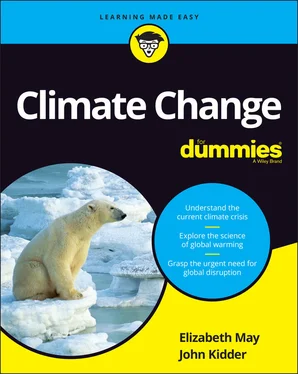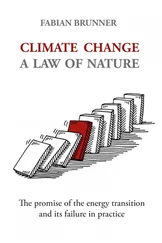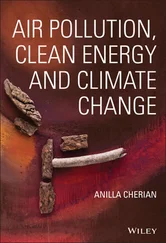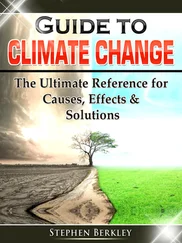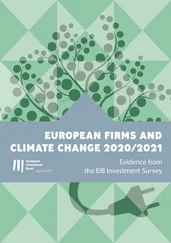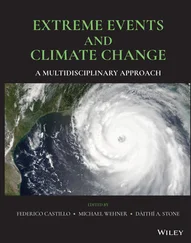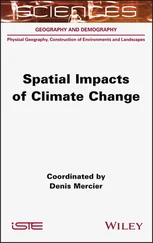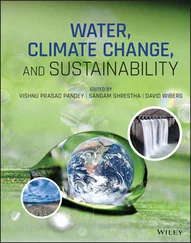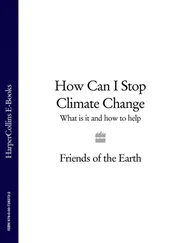66 million years ago: An asteroid hits eastern Mexico, the cloud of dust and steam blocks the sun for years, plants die, and the dinosaurs (and all other animals weighing more than 55 pounds [25 kg]) go extinct.
55 million years ago: Another mass extinction happens, this one perhaps caused by a rise in greenhouse gases, that make the atmosphere a more effective insulator and causes Earth to heat past the survival limits of many species. It’s a tough place to live, Earth. Nothing is certain.
6 million years ago: The first humans appear.
Human beings have been around in the same basic form for 6 million of the 5 billion years of Earth, one-eighth of one percent of all that time. During that (short) time, humans survived ice ages and developed tools, agriculture, writing, states and governments, music, and art. The human population grew constantly but slowly, held within the limits of what Earth and natural processes could provide, at about 0.04 percent per year, from 10,000 BC to 1700 AD. By 1700 about 600 million people lived on Earth, rising to about 1 billion by 1800.
But then things changed. Between 1800 and 1928, the human population doubled to 2 billion. From then on, the rate of increase rose rapidly until about 1968 — and population went up to 2.5 billion, to 5 billion by 1987, and 7.7 billion by 2019. The rate of increase peaked in 1968 and has been decreasing ever since, but still the population is expected to rise to a maximum of about 11 billion by 2100.
So humans have come to dominate Earth as no other life form ever has. And it’s not just people — the animals that humans keep are now by far the largest part of the world’s total animal biomass ( biomass is the total mass of living matter in a given area).
In addition to the rising population, humans learned in the early part of the 1800s how to use the energy stored in the Earth millions of years ago. It all came from those old plants that millions of years ago used energy from the sun to grow and make their carbon tissue. When the plants died, their tissues rotted and decomposed, and over millions of years were compressed into coal and oil.
Beginning to use fossil fuels
Black or brown coal, the compressed remains of ancient plants, is a wonderful source of high-density energy. It’s sometimes easy to find on the surface of the Earth, so it has been used for thousands of years for fuel (and humans had learned to make a sort of coal equivalent, charcoal, by heating wood without enough oxygen to actually burn). But most of the coal in the world is underground, not so easy to pick up and take home to the fire. People dug shallow mines to get the coal out, but often water would flood in and prevent further digging.
And then came the revolution, the start of what this book is about.
In the late 1700s and early 1800s, a Scottish engineer named James Watt made the first steam engines with high enough efficiency to be used to reliably pump water out of coal mines. So the coal provided the fuel to heat the water to make the steam to drive the engine to work the pump to get rid of the water to get at the coal, and the Industrial Revolution was launched.
With abundant coal, industrial applications became possible all over England. Engines made by Watts and others drove all sorts of processes, factories of all sorts, wool and cotton spinning, steam looms, steel mills, railroads and steamships: Coal powered England to become the first great industrial empire. The technology was then exported around the world, to Europe and the new states in America, and industrial output exploded.
With this new kind of industry, people began to be employed in large numbers in centralized locations. The move from the country to the cities accelerated. In the cities, coal was burned for heat, for hot water, and “coal gas” lit indoor and outdoor spaces. People worked longer hours of work and enjoyed evening entertainments in theaters and music halls.
But wait. There's still more.
The second Industrial Revolution begins
In 1859, oil was produced from a well in Pennsylvania, and the second Industrial Revolution began. Coal remained dominant for a long time, but the use of oil and its companion product methane gas (called natural gas to help with marketing) grew rapidly until the use of oil equaled coal by the 1950s and then displaced coal from most uses (except to make electricity and steel) by the 1970s. Oil is easier to handle than coal, produces more usable energy with less smoke and soot, and is just a better fuel source for railroads and ships, for industry, and for electrical generation. So King Coal lost its crown.
But humans were making more and more stuff and were still burning a lot of coal and now a lot of oil and gas as well. When that coal and oil was burned, humans got to use that ancient solar energy again to make things and move things and keep things warm. And all that carbon was released again, off into atmosphere as carbon dioxide and other gases called greenhouse gases because they act like the glass in a greenhouse to keep heat in. So, like any good greenhouse, the Earth became warmer. And it’s still getting warmer today. And that’s the problem to solve.
Tapping into The Roots of Global Warming
Just what are humans doing to release all those GHGs into the atmosphere? You can pin the blame on two main offenses, which we discuss in the following sections: burning fossil fuels and deforestation.
When you burn fossil fuels, such as coal and oil (named fossil fuels because they’re composed of ancient plant and animal material), they release vast amounts of GHGs (largely, but not exclusively, carbon dioxide), which trap heat in the atmosphere. Fossil fuels are also a limited resource — meaning that humanity can’t count on them over the long term because eventually they’ll just run out.
The fossil fuel that produces the most GHG emissions is coal, and burning coal to produce electricity is the major source of coal-related GHGs. The second-worst offender is using gasoline and diesel for transportation, followed by burning oil to generate heat and electricity. In fact, if people could replace the coal-fired power plants around the world and switch away from the internal combustion engine, humanity would have most of the problem licked. This switch is happening now, more and more quickly, but industries that have been built on the fossil fuel bonanza, and their supportive governments and bankers, continue to delay the inevitable progress. (Check out Chapter 4for more fossil fuel info, Chapter 13for the scoop on energy alternatives, and Chapter 17for an introduction to the disruption expected and feared by those industries.)
Heating up over deforestation
Forests, conserved land, and natural habitats aren’t important just for the sake of saving trees and animals. Forests and all greenery are important players in keeping the climate in check. Plants take in the carbon that’s in the atmosphere and give back oxygen, and older trees hold on to that carbon, storing it for the duration of their lives. By taking in carbon dioxide, they’re significantly reducing the greenhouse effect. (See Chapter 2for more about how plants help the Earth keep atmospheric carbon at a reasonable level.)
Unfortunately, much of the world’s forests have been cut down to make way for farmland, highways, and cities. Deforestation is responsible for about a quarter of GHG emissions. Rainforests and mangrove forests (very productive forests that grow in wetlands) are especially good at soaking up carbon dioxide because they breathe all year round. Temperate forests, on the other hand, don’t absorb much carbon dioxide over the winter, practically going into hibernation. ( Chapter 5has more about deforestation.)
Читать дальше
